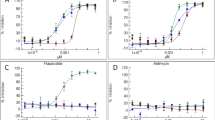Abstract
Macrosiphum euphorbiae, also known as the potato aphid, is a potato virus vector, associated with decreased tuber production. Feeding, toxicity, and reproductive effects of the major potato glycoalkaloids (α-chaconine and α-solanine), their common aglycone (solanidine), and a nonpotato glycoalkaloid (α-tomatine) and its aglycone (tomatidine) onM. euphorbiae were studied. As expected, neither α-chaconine nor α-solanine had a strong lethal effect on the aphid, but α-chaconine stimulated feeding at low concentrations. Both aglycones were deterrent and lethal at high concentrations and, like α-chaconine and α-tomatine, they delayed the appearance and decreased the number of nymphs.
Similar content being viewed by others
REFERENCES
AUCLAIR, J. L. 1989. Host plant resistance, pp. 248–250,in A. K. Minks (ed.). Aphids, Their Biology, Natural Enemies and Control. Elsevier Science Publishers.
BUSVINE, J. R. 1957. A Critical Review of the Techniques for Testing Insecticides, Eastern Press, London, pp. 6–11. ai]DE BOKX, J. A. 1980. Virosis de la papa y de la semilla de papa, Editorial Hemisferio Sur S.A., Buenos Aires, pp. 147–165.
DREYER, D. L.,REESE, J. C., andJONES, K. C. 1981. Aphid feeding deterrents in sorghum.J. Chem. Ecol. 7:273–284.
DREYER, D. L.,JONES, K. C., andMOLYNEAUX, R. J. 1985. Feeding deterrency of some pyrrolizidine, quinolizidine and indolizidine alkaloids towards pea aphidAcyrthosiphum pisum and evidence for phloem transport of indolizidine alkaloid swainsonine.J. Chem. Ecol. 11:1045–1051.
FEBVAY, G.,PUGEAUX, J. F., andBONNOT, G. 1992. Lipid composition of the pea aphid, Acyrtosiphum pisum (Harris) (Homoptera: Aphididae), reared on host plant and on artificial media.Arch. Insect Biochem. Physiol. 21:103–118.
FEWELL, A. M., andRODDICK, J. G. 1993. Interactive antifungal activity of the glycoalkaloids α-solanine and α-chaconine.Phytochemistry 33:323–328.
FEWELL, A. M.,RODDICK, J. G., andWEISSENBERG, M. 1994. Interaction between the glycoalka-loids solasonine and solamargine in relation to inhibition of fungal growth.Phytochemistry 37:1007–1011.
FRIEDMAN, M.,MC DONALD, G., andHADDON, W. F. 1993. Kinetics of acid-catalyzed hydrolysis of carbohydrate groups of potato glycoalkaloids α-chaconine and α-solanine.J. Agric. Food Chem. 41:1397–1408.
GREGORY, P. 1984. Glycoalkaloid composition of potato: Diversity and biological implications.Am. Potato J. 61:115–122.
KEUKENS, E. A. J.,DE VRIJE, T.,JANSEN, L. A. M.,DE BOER, H.,JANSSEN, M.,DE KROON, A. I. P. M.,JONGEN, W. M. F., andDE KRUIJFF, B. 1996. Glycoalkaloids selectively permeabilize cholesterol containing biomembranes.Biochim. Biophys. Acta 1279:243–250.
MAGA, J. 1994. Glycoalkaloids in Solanaceae.Food Rev. Int. 10:285–314.
MONTLLOR, C. B. 1991. The influence of plant chemistry on aphid feeding behavior, pp. 125–175,in E. Bernays (ed.). Insect Plant Interactions, Vol. III. CRC Press, Boca Ratón.
NIEMEYER, H. M. 1988. Hydroxamic acids defense chemicals in the Graminaceae.Phytochemistry 27:3349–3358.
NORRIS, D. M. 1986. Antifeedant Compounds, pp. 97–146,in H. Haug and H. Hoffman (eds.). Chemistry of Plant Protection. Springer, Berlin.
POLONSKY, J.,BHATNAGER, S. C.,GRIFFITHS, D. C.,PICKETT, J. A., andWOODCOCK, C. M. 1989. Activity of quassinoids as antifeedants against aphids.J. Chem. Ecol. 15:993–998.
RAYBURN, J. R.,BANTLE, J. A., andFRIEDMAN, M. 1994. Role of carbohidrate side chains of potato glycoalkaloids in the developmental toxicity.J. Agric. Food. Chem. 42:1511–1515.
RODDICK, J. G. 1982. Distribution of steroidal glycoalkaloids in reciprocal grafts ofSolanum tubersosum andLycopersicon esculentum.Experientia 38:460–462.
RODDICK, J. G. 1989. The acetilcholinesterase inhibiting activity of steroidal glycoalkaloids and their aglycones.Phytochemistry 28:2631–2634.
RODDICK, J. G., andRIJNENBERG, A. L. 1987. Synergistic interaction between the potato glycoalkaloids α-solanine and α-chaconine in relation to lysis of phospholipid/sterol liposomes.Phytochemistry 26:1325–1328.
RODDICK, J. G.,RIJNENBERG, A. L., andWEISSENBERG, M. 1990. Membrane disrupting properties of the steroidal glycoalkaloids solasonine and solamargine.Phytochemistry 31:1951–1954.
SANFORD, L. L.,DEAHL, K. L.,SINDEN, S. L., andLADD, T. L. 1990. Foliar solanidine glycoside levels inSolanum tuberosum populations selected for potato leafhopper resistance.Am. Potato J. 67:461–466.
SCHREIBER, K. 1979. The steroid alkaloids ofSolanum, pp. 193–202,in J. G. Hawkes (ed.). The Biology and Taxonomy of the Solanaceae, Linnean Society Symposium Series No. 7. Academic Press, New York.
SINDEN, S. L.,GOTH, R. H., and O'BRIEN, J. 1973. Effect of potato glycoalkaloids on the growth ofAlternaria solanii and their possible role as factors in potatoes.Phytopathology 63:303–307.
SNEDECOR, G. W., andCOCHRAN, W. G. 1977. Métodos Estadísticos, Co. Editorial Mexicana, Mexico, pp. 123–156.
SRIVASTAVA, P. N., andAUCLAIR, J. L. 1971. An improved chemically defined diet for the pea aphid,Acyrtosiphum pisum.Ann. Entomol. Soc. Am. 64:474–478.
STEEL, C. C., andDRYSDAIL, R. B. 1988. Electrolicage from plant and fungal tissues and disruption of liposome membranes by α-tomatine.Phytochemistry 27:1025–1028.
TINGEY, W. M. 1984. Glycoalkaloids as pest resistance factors.Am. Potato J. 67:461–466.
VAN GELDER, W. M. J.,VINKE, J. H., andSCHEFFER, J. J. C. 1988. Steroidal glycoalkaloids in tubers and leaves ofSolanum species used in potato breeding.Euphytica 37:147–158.
Author information
Authors and Affiliations
Rights and permissions
About this article
Cite this article
Güntner, C., González, A., Reis, R.D. et al. Effect ofSolanum Glycoalkaloids on Potato Aphid,Macrosiphum euphorbiae . J Chem Ecol 23, 1651–1659 (1997). https://doi.org/10.1023/B:JOEC.0000006429.14373.91
Issue Date:
DOI: https://doi.org/10.1023/B:JOEC.0000006429.14373.91




